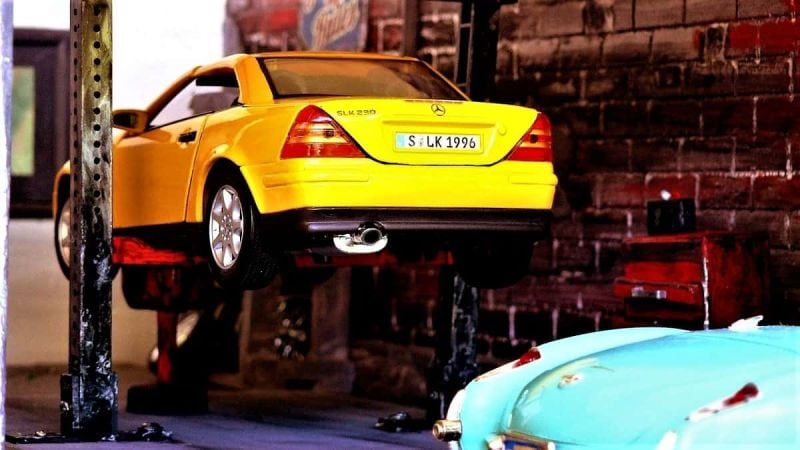The CV Axle Scare Tactic
This is a common scam scenario: You drive into a quickie oil change service center for a cheap oil and filter change only to have a technician come to you with a clipboard in hand stating that while the filter was being replaced another tech found that the CV axle boots were cracked or broken and that grease had leaked out of the CV axle joint rendering your vehicle unsafe to drive.
Mr. Clipboard might even let you take a look at the CV boots while your vehicle is on the lift to see that yes---it is cracked, and yes---there is caked grease on the assembly. What you don’t know for sure is whether or not the boots had been cut and grease smeared to support a ruse.
Related article: Two Service Center Mechanic Scams That Are Easy to Spot If You Know Where to Look Under the Hood
But this is beside the point. The point here is that you may not have noticed anything wrong before this visit related to your axle that would indicate a dangerous driving condition that needs to be corrected immediately. When a CV axle is going bad and nearing dangerous wear, you will notice it, even though you might not know what exactly is going on.
CV Axle Basics
CV (Constant Velocity) axles serve as the link between your car’s engine with the wheels. Their job is to transfer torque from the drivetrain to your wheels to get your car moving. The CV axle is articulated with joints so that the axle can spin freely while the wheels are being cut to the left and the right without binding the axle as you make turns.
At these joints there are rubber boots to contain grease for lubricating the joint and to prevent dirt and water from getting into the joint and causing premature wear. When the boots are cracked and broken, dirt will eventually get into the joint and cause enough wear to make the axle assemblage slop around---usually with some indication that will get your attention.
Signs of excessive wear and assemblage slop include:
• Loud clicking or popping noises when turning or accelerating.
• Difficulty with steering when making turns and/or rounding corners.
• Excessive vibration while driving due to the joint or axle becoming imbalanced which leads to axle vibration that you will feel as you are driving.
Signs of acceptable (for the immediate moment) wear and tear include:
• Cracked or broken rubber boots.
• Grease leaking from around the boot.
• Grease on the inner side of the wheel.
The point here is that many used cars with some mileage on them will have normal wear and tear of the boots and some grease leakage, but still have joints and an axle that are safely functional enough not to warrant an immediate repair.
In the storied customer’s case in the video below, Ray from Rainman Ray’s Repairs points out that there is normal wear and tear going on with the vehicle, but nothing dangerous as the lube center tech and Mr. Clipboard would have the car owner believe.
Related article: Repair Scams Only Another Mechanic Could Catch
Here is the video posted below. Only the first few minutes are topic-specific, the majority of the remaining video is Ray showing viewers how a CV axle is replaced on this VW Passat---worth watching, but not necessary to understand the scam going on.
Rip-off Shop says "Dangerous to Drive!" Here I come to WRECK YOUR DAY! Volkswagen Passat
And finally…
One note to this video is that if you follow the post video comments you will see some discussion about whether Ray should have just replaced the boots at a lower cost to the owner rather than wind up replacing both of the CV axle shaft assemblies with new ones.
In many cases, replacing the boots and repacking grease into the joints are all that is needed when the CV axle shaft assembly does not appear to be overly wore out. It’s a judgment call between the mechanic and the customer where the cost of repair, safety risk, value of the vehicle, projected ownership period, etc., are weighed to determine the needed course of action.
Since the labor is the biggest part of the cost regardless of which route is taken, it is normal to play it safe by installing a new CV axle. The interesting counterargument is whether the replacement Chinese CV axle shaft assemblies are any better than a worn OEM CV axle. It’s a judgment call.
For additional articles about service center scams, here are some selected articles for your consideration: “Car Repair Scam Outed by Mechanic is a Lesson to Car Owners” and “Common Brake Repair Scam in Major Name Tire Centers.”
COMING UP NEXT: Just Rolled In Friday
Timothy Boyer is a Torque News automotive reporter based in Cincinnati. Experienced with early car restorations, he regularly restores older vehicles with engine modifications for improved performance. Follow Tim on Twitter at @TimBoyerWrites for daily new and used vehicle news.
Image Source: Pixabay













Comments
"The interesting
Permalink
"The interesting counterargument is whether the replacement Chinese transaxle is any better than a worn OEM transaxle." For clarity the multiple references to changing the transaxle / transaxle assembly is incorrect. A transaxle is the entire transmission where a cv axle shaft assembly is just the axle shaft and two cv joints. Sometimes the axle assembly is called a cv axle but never a transaxle.
You are correct. I'm writing
Permalink
In reply to "The interesting by Rjp (not verified)
You are correct. I'm writing too fast---thanks for the catch. I'll make the changes. Appreciate the input!